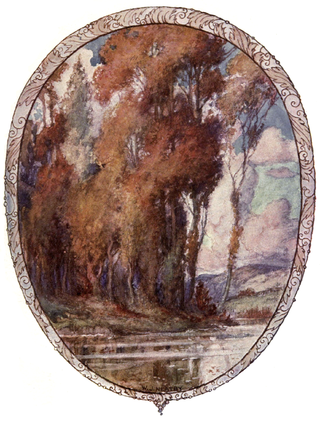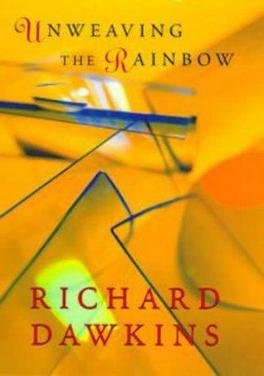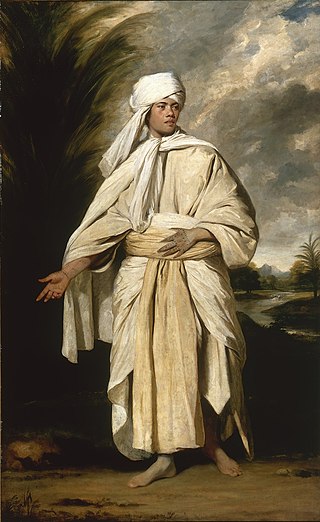
Sir Humphry Davy, 1st Baronet, was a British chemist and inventor who invented the Davy lamp and a very early form of arc lamp. He is also remembered for isolating, by using electricity, several elements for the first time: potassium and sodium in 1807 and calcium, strontium, barium, magnesium and boron the following year, as well as for discovering the elemental nature of chlorine and iodine. Davy also studied the forces involved in these separations, inventing the new field of electrochemistry. Davy is also credited with discovering clathrate hydrates.

John Keats was an English poet of the second generation of Romantic poets, along with Lord Byron and Percy Bysshe Shelley. His poems had been in publication for less than four years when he died of tuberculosis at the age of 25. They were indifferently received in his lifetime, but his fame grew rapidly after his death. By the end of the century, he was placed in the canon of English literature, strongly influencing many writers of the Pre-Raphaelite Brotherhood; the Encyclopædia Britannica of 1888 called one ode "one of the final masterpieces".
Hyperion, a Fragment is an abandoned epic poem by 19th-century English Romantic poet John Keats. It was published in Lamia, Isabella, The Eve of St. Agnes, and Other Poems (1820). It is based on the Titanomachia, and tells of the despair of the Titans after their fall to the Olympians. Keats wrote the poem from late 1818 until the spring of 1819. The poem stops abruptly in the middle of the third book, with close to 900 lines having been completed. He gave it up as having "too many Miltonic inversions." He was also nursing his younger brother Tom, who died on 1 December 1818 of tuberculosis.

Caroline Lucretia Herschel was a German astronomer, whose most significant contributions to astronomy were the discoveries of several comets, including the periodic comet 35P/Herschel–Rigollet, which bears her name. She was the younger sister of astronomer William Herschel, with whom she worked throughout her career.

"To Autumn" is a poem by English Romantic poet John Keats. The work was composed on 19 September 1819 and published in 1820 in a volume of Keats's poetry that included Lamia and The Eve of St. Agnes. "To Autumn" is the final work in a group of poems known as Keats's "1819 odes". Although personal problems left him little time to devote to poetry in 1819, he composed "To Autumn" after a walk near Winchester one autumnal evening. The work marks the end of his poetic career, as he needed to earn money and could no longer devote himself to the lifestyle of a poet. A little over a year after the publication of "To Autumn", Keats died in Rome.

"Ode on a Grecian Urn" is a poem written by the English Romantic poet John Keats in May 1819, first published anonymously in Annals of the Fine Arts for 1819.

Unweaving the Rainbow: Science, Delusion and the Appetite for Wonder is a 1998 book by the evolutionary biologist Richard Dawkins, in which the author discusses the relationship between science and the arts from the perspective of a scientist.

"On First Looking into Chapman's Homer" is a sonnet written by the English Romantic poet John Keats (1795–1821) in October 1816. It tells of the author's astonishment while he was reading the works of the ancient Greek poet Homer as translated by the Elizabethan playwright George Chapman.
"Lamia" is a narrative poem written by the English poet John Keats, which first appeared in the volume Lamia, Isabella, the Eve of St Agnes and Other Poems, published in July 1820. The poem was written in 1819, during the famously productive period that produced his 1819 odes. It was composed soon after his "La Belle Dame sans Merci" and his odes on Melancholy, on Indolence, on a Grecian Urn and to a Nightingale and just before "To Autumn".
Lynda Hull was an American poet. She had published two collections of poetry when she died in a car accident in 1994. A third, The Only World, was published posthumously by her husband, the poet David Wojahn, and was a finalist for the 1994 National Book Critics Circle Award. Collected Poems By Lynda Hull, was published in 2006.
Water gas is a kind of fuel gas, a mixture of carbon monoxide and hydrogen. It is produced by "alternately hot blowing a fuel layer [coke] with air and gasifying it with steam". The caloric yield of the fuel produced by this method is about 10% of the yield from a modern syngas plant. The coke needed to produce water gas also costs significantly more than the precursors for syngas, making water gas technology an even less attractive business proposition.

Mai, also known as Omai in Europe, was a young Ra'iatean man who became the first Pacific Islander to visit England, and the second to visit Europe, after Ahutoru who was brought to Paris by Bougainville in 1768.

19th-century science was greatly influenced by Romanticism, an intellectual movement that originated in Western Europe as a counter-movement to the late-18th-century Enlightenment. Romanticism incorporated many fields of study, including politics, the arts, and the humanities.
Nationality words link to articles with information on the nation's poetry or literature.

Richard Gordon Heath Holmes, OBE, FRSL, FBA is a British author and academic best known for his biographical studies of major figures of British and French Romanticism.
Richard Marggraf Turley is a British literary critic, poet and novelist. He specialises in Romanticism and the poetry of John Keats, surveillance studies and ecocriticism. He is professor of English Literature at Aberystwyth University, and between 2013 and 2018 was that institution's Professor of Engagement with the Public Imagination.

Bright Star is a 2009 biographical romantic drama film, written and directed by Jane Campion. It is based on the last three years of the life of poet John Keats and his romantic relationship with Fanny Brawne. Campion's screenplay was inspired by a 1997 biography of Keats by Andrew Motion, who served as a script consultant.

Percy Bysshe Shelley was an English writer who is considered one of the major English Romantic poets. A radical in his poetry as well as in his political and social views, Shelley did not achieve fame during his lifetime, but recognition of his achievements in poetry grew steadily following his death, and he became an important influence on subsequent generations of poets, including Robert Browning, Algernon Charles Swinburne, Thomas Hardy, and W. B. Yeats. American literary critic Harold Bloom describes him as "a superb craftsman, a lyric poet without rival, and surely one of the most advanced sceptical intellects ever to write a poem."
Sir William Watson (1744–1824) was an English physician and naturalist, elected a Fellow of the Royal Society in 1767 and knighted in 1796. He was mayor of Bath in 1801.
Age of Wonder may refer to:












